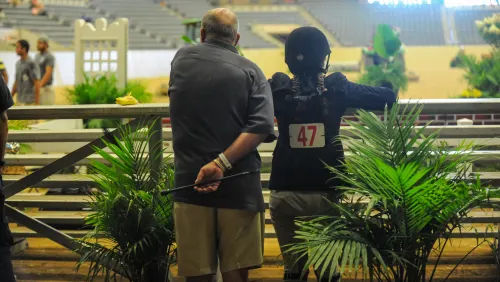Sunday was the first of our Fix-A-Test events, where I “judge” tests and then give the riders a few minutes of coaching afterwards. I really like these conceptually. It’s good for the rider—to get to really focus on a piece of the test; it’s good for me—to practice wearing a judge’s hat (I’d like to finish the L program and get my judge’s license, someday); and it’s good for the farm to get exposure to lots of new riders.
I set up our particular Fix-A-Tests to be as relaxed and inviting as possible—no dress code, no braiding, and we’re not even following USEF tack rules. If a rider wanted to show without a noseband, or do the Prix St. Georges in a snaffle, or whatever, we’re game. As a result, my last rider (who is a student of mine, and a LOVELY rider and person) brought a horse I’d seen before, but in tack I’d never seen—a bitless bridle.
This particular horse is an older mare that was backed in a less-than-fair bit. As a result, her rider has spent their career together trying to get the mare to take the bridle in a nice way, and she’s had a hard time. They’ve tried plastic bits, rubber bits, you-name-it bits, and on a lark borrowed a neighbor’s bitless.
Bitless bridles cause quite a kerfluffle if you mention them on an Internet bulletin board, and I have been firmly in the camp that USEF dressage competitions are no place for a bitless bridle—how can a horse accept a bit that isn’t there?
And then I saw this mare go.
ADVERTISEMENT
A supple, swinging back, a soft expression, and the kicker—a chewing, salivating jaw. She had a foamy mouth with no bridle, and she happily licked and chewed her way through a 70 percent Training level ride. For this horse, the bitless bridle made the difference between night and day.
I’m not defecting to the bitless camp. The rules we’ve devised for USEF competition require a bit to accept, and taking that bit out would be a little like playing baseball with a tennis ball—the same basic picture, but the devil’s in the details. Still, there is something to be said for maximizing a horse’s comfort, and when there’s a major hurdle in the training to overcome, there’s a clear call for thinking outside the box.
Was it “dressage” I saw yesterday, with my bitless pair? Maybe, maybe not. What it undoubtedly was? Good horsemanship. And there’s always room for that, inside and out of the show ring, no matter the discipline.















